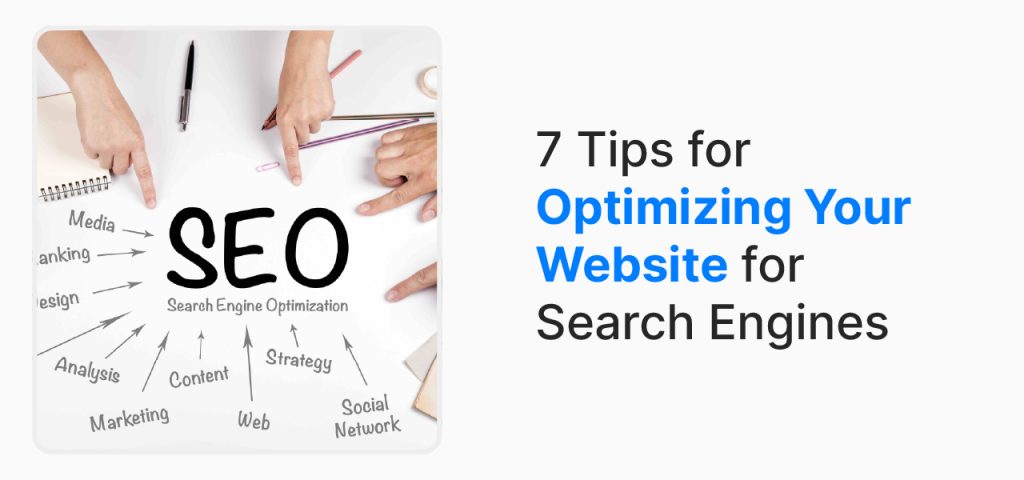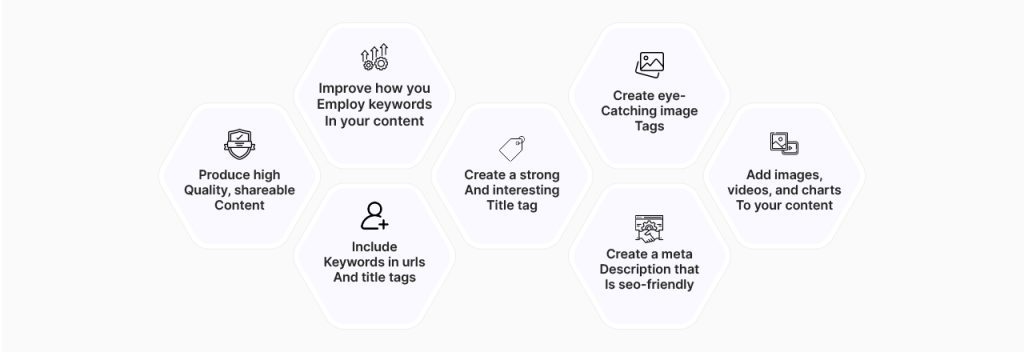

7 Tips for Optimizing Your Website for Search Engines
One of the most effective methods for achieving higher search engine rankings is to have a well-optimized website. But it feels overwhelming, especially because you have no idea where to start.
Getting your website optimized to rank higher in SERPs is a great way to enhance conversions and organic visitors.
Developing an effective SEO strategy mostly relies on optimizing a website to attain higher search engine ranks.
In order to do this, it is crucial to continually offer excellent information that is pertinent to your consumers’ needs while making sure that your website complies with the correct formatting guidelines and displays properly.
One must first understand the relevance of the “search engine friendly” principle in order to construct an SEO-optimized website that is conducive to getting higher ranks.
To provide their consumers with search results that are incredibly relevant, almost all search engines regularly improve their algorithms. Given the intense competition in the relevant market, rising in the SERPs increases the chances of drawing in highly qualified leads and gaining greater awareness.
As you continue to create material that adds value and tackles issues pertinent to the needs of your target audience, you’re giving yourself a competitive edge over rivals who might not have as much information easily available on their websites.
The importance of search engine optimization for your website’s growth and visibility online will be covered in this article.


Produce high-quality, shareable content
It is crucial to produce content that people want to share. Although it may be tempting to concentrate only on offering useful content, it is crucial to make sure that the essay is original, captivating, and engaging.
When creating content that is SEO-friendly, it’s crucial to keep in mind that the reader should find it engaging.
Don’t ignore how simple it is for people to distribute the information given on the internet. People might not be interested in your material if they can’t easily share your piece on their blog or website.
A social sharing button that enables people to share links straight from your website by clicking a button should be included on your website. In this approach, the blog entries on your website can be widely disseminated online and considered independent social media posts for all social media networks.
Without a question, creating engaging and high-quality content is the best way to promote your website for free or improve its search engine results. What does “high-quality” mean in this context, though?
To put it another way, you need to develop original content that connects with your audience. The material might be anything, from pieces highlighting current trends in the sector to practical advice and pointers targeted at assisting people in achieving their goals.
The information you present must also be worthwhile and important; otherwise, the reader will be left with no use for it.
Improve how you employ keywords in your content
It may seem like a difficult task to get your website optimized for search engine results, but it is not impossible. Once you start managing your website effectively by breaking things down into manageable portions, you will start seeing benefits right away.
The best strategy to guarantee that your website is optimized for higher ranks is, by far, to begin by optimizing the content of your website.
The likelihood that the keyword phrases will be discovered by people looking for the information you offer increases as you add more focused keywords that are scattered throughout the content of your website.
No matter what business you are in, you should follow these recommendations. In order to find out about the most recent developments in term usage in a specialized sector like SaaS, have a look at this SaaS SEO guide.
In the meantime, the following tips can be applied to optimize the keyword usage in your content:
To make your pages more discoverable, make sure they all contain title tags and meta descriptions.
Make sure each piece of writing includes at least one long-tail keyword phrase or several of them. Compared to keyword phrases with only one word, the latter will typically help to increase online visibility.
Instead of repeating the same sentence, try employing different word choices or phrases within the same paragraph.
Ensure you’re not overloading your webpage with keywords – you should only incorporate keywords when necessary to ensure that your visitors will not be overwhelmed with too many search results.
Include Keywords in URLs and Title Tags
Keywords ought to be used in both title tags and URLs. When a visitor first visits your website, URLs are the first thing they see. Use one or two keywords to help it stand out as a result.
The title tag must contain keywords because they will show up on SERPs. Try to use a SERP checker for a thorough study of SERP performance to help your SEO efforts.
Additionally, you should include keywords in your material. Because search engines cannot read minds, they instead analyze user browsing patterns to determine how popular a topic is by examining how closely it ties to other topics.
Therefore, if you want readers to recognize your command of search engine optimization as a competence, frequently include the related terms in your content – at least once every 100 words or once every paragraph.
As was previously noted, including keywords while optimizing a website for search engine results entails including the keywords in the title tags and URLs.
The question of whether keywords are required when naming the webpage is another area that causes uncertainty. It’s important to note that if you name your pages after keywords and include them in the URL, search engines will rank them higher.
Anyhow, there is no rule stating that keywords must be used just for their purpose. Since it is not permissible for a website to attempt to influence search engine rankings, the practice of stuffing keywords may result in Google penalizing your page.
Instead of repeating the same keyword phrase in your page title or meta description tag, you might use synonyms or related terms.
Create a Strong and Interesting Title Tag


The title tag is a critical component of on-page SEO. Consequently, you should focus your efforts on strengthening them.
The title tags are useful resources to improve user satisfaction and online exposure because they could show up on SERPs as hyperlinked titles associated with particular search queries. It gains from linked searches, navigation, and rankings, three views.
Making your title tag catchy and meaningful is crucial because it will be one of the first things visitors notice while searching your website.
One of the first components a search engine will see when indexing your page is a title tag. In order to ensure that the right keywords are used and the pages are optimized for user searches, Google uses title tags to assess the relevance of your pages depending on the search terms.
Because it is one of the first elements that may be hidden when the user scrolls down the page, writing a strong title tag may seem challenging.
As a result, if they are viewed on a laptop or desktop computer, any images or widgets listed above your core content area are likely to be covered by the secondary content.
It could be more logical to develop two distinct titles: a first title that uses pertinent keywords as an introduction and a second title that uses keywords that are particular to the goods or services being sold.
Create a Meta Description That Is SEO-Friendly


A website’s content can be described using the HTML tag known as the meta description. These details are used by search engines to determine how and how much space your webpage should occupy in search results.
Therefore, it’s critical to create strong and intriguing descriptions that effectively communicate your business message while luring potential customers to stay for longer.
Avoid purposely overusing phrases like “the greatest” and “top,” as they are frequently used and no longer have the same meaning they once did.
In addition, you should avoid using ambiguous language in your description. Instead, you should focus a lot on creating a unique meta description for each page of your website, ensuring it’s no more than 160 characters.
Add Images, Videos, and Charts To Your Content
By including photographs, videos, or other media in your blog posts, you can increase the perceived value of the content on your website. You will improve Google’s capacity to understand what you mean by adding some breaks to your text.
A great illustration is a picture with a caption that describes a specific step in the process. Another choice is to utilize a video to lead the reader through the process by either demonstrating it or just showing you doing the activity.
Use visuals to give your speech a sense of emotion. If you can provide visual evidence to support your assertions on your website, be sure to do so. When attempting to facilitate your website design efforts, a number of logo design designs might serve as visual proof.
They can be used to determine the legitimacy of any topic, allowing you to include any graphic content on your website.
One of a website’s most important components is the integration of photographs or video. They provide a better user experience as a result, which boosts website rankings, conversions, and CTRs.
As a result, you should include them in the body content as well as the homepage. Images also make it easier for your audience to understand the idea you’re attempting to get over. Even better, add graphics and graphic components to your written content.
Any artistic elements and pictures might enhance the allure of your website. To create something unique, you can also get ideas from online logo-making resources.
Last but not least, make an effort to structure your material so that it is easy for users to swiftly navigate the page without being overwhelmed by information by using subheadings, lists, and bullet points to assist divide large blocks of text.
Create Eye-Catching Image Tags
Make sure your website’s embedded photos have been properly optimized for search engine placement whenever you do so. Don’t forget to name your files correctly, format them properly, and arrange them properly on the following pages and sections.
One of the most important components of website SEO is producing succinct, high-quality content for every page of the website. Each image should have an image tag to increase its search engine visibility.
Keyword words that are pertinent to the particular industry should be included in image tags, as should any other phrases that visitors to your website would hunt for.
Additionally, make sure the photographs you choose are of a high caliber so that people using PCs or smartphones to access the website can view them more easily.
Wrap Up
A long-term commitment is necessary to optimize your website for search engines, and it may take months or even years to complete. Maintaining patience while being realistic about how long it will take is the key to success.
Furthermore, it’s crucial to avoid getting discouraged by a lack of immediate improvement. Before you start noticing any visible changes in the ranks of your website, you might need to wait a bit.
However, if you continue to consistently improve the functionality of your website, you will notice that your efforts start to bear fruit over time.
It takes time and consistent effort to optimize your website for search engines; it is not something you can do overnight. Let’s say you persist, keep up your optimization work, and make sure that each component of your website is correctly optimized in accordance with Google’s recommendations.
If so, you’ll notice that more and more individuals are seeing links from Google that lead directly to your website. Try to put the aforementioned advice into practice for a better result so that your website optimization efforts can start to pay off.
Infotanks Media is a B2B data-driven company & digital marketing agency providing performance services to businesses online so they can access diverse media platforms.
If you are hunting for someone that can enhance your brand image, influence your buyers more often and increase the generated revenue through their exceptional online marketing services then our dedicated online marketing team can help you reach, grow and convert your web-based audience.
Using our vast experience in running campaigns we achieve top results in keyword rankings on SERPs, deliver high-quality content, and ingeniously learn off-page & on-page SEO that helps you gain more traffic and increase conversions.



















Write A Comment